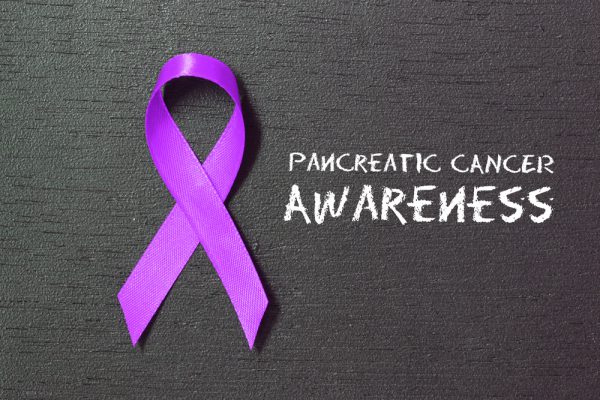Pancreatic Cancer: What You Need to Know
The Pancreatic Cancer Action Network (PanCAN) estimates that more than 57,000 Americans will be diagnosed with pancreatic cancer in 2020. If you, a loved one, or a friend have been diagnosed with this deadly disease, being informed is the first step in the long journey toward fighting pancreatic cancer.

What is Pancreatic Cancer?
The pancreas is a gland in the abdomen that makes enzymes to help digestion and hormones that keep blood sugar at a normal level. When cells in the pancreas form too rapidly—or old cells don’t die—they form a mass called a tumor.
Tumors are either benign or malignant. Benign pancreatic tumors stay in the abdomen, while malignant pancreatic tumors often spread to the liver, lungs, bones, abdominal walls, or lymph nodes.
Who Gets the Disease?
Pancreatic cancer is the ninth most common cancer diagnosis for women in the U.S. and the tenth most common for men. The exact cause of the disease is not known.
While most pancreatic cancers occurs at random, experts at PanCAN have identified several risk factors, including:
- Chronic or Hereditary Pancreatitis
- A Long History of Diabetes
- Age—Adults Over Age 60
- Gender—Male
- Ancestry—African-American or Ashkenazi Jewish
- Smoking
- Obesity
- A Diet High in Red or Processed Meats
Heredity accounts for five to 10 percent of pancreatic cancers. According to PanCAN, people have a higher if of developing the disease if they have:
- Two or more first-degree relatives who have been diagnosed with the disease
- A first-degree relative who was diagnosed before the age of 50
- An inherited genetic syndrome associated with pancreatic cancer
What Are the Early Warning Signs and Symptoms?
Because pancreatic cancer tends to grow quietly, patients don’t typically notice the warning signs or symptoms. In fact, symptoms can be mistaken for physical changes to the body or less serious health issues.
A few of the early warning signs and symptoms include:
- Pain in the Back or Abdomen
- Abdominal Bloating
- Digestive Issues—Loss of Appetite, Indigestion, or Frequent Nausea
- Unaccountable Weight Loss
- Jaundice
- A Change in the Texture or Smell of a Person’s Stool
How Is Pancreatic Cancer Diagnosed?
According to the American Cancer Society, screenings for pancreatic cancer is not recommended for people at average risk of developing the disease. And screening tests do not lower the risk of death.
Since the pancreas is located deep in the abdomen, a doctor can’t see or feel tumors during a routine physical exam. Because of this, it is difficult to diagnose the disease in its early stages.
If a patient is experiencing symptoms of pancreatic cancer, a doctor can order blood work, imaging tests such as an x-ray, MRI, or CT scan, or a biopsy. These tests help identify tumors or the reason behind the symptoms.
People with a family history of pancreatic or other certain types of cancer can opt to undergo genetic testing. These tests look for changes in the genes that can cause inherited conditions, which increase the risk of developing pancreatic cancer.
What Are the Treatment Options?
Treatment options for the disease vary depending on the type of pancreatic cancer that is diagnosed. The most common type is exocrine. Other types include:
- Pancreatic Adenocarcinoma
- Adenosquamous Carcinomas
- Squamous Cell Carcinomas
- Signet Ring Carcinomas
- Ampullary Cancer
Each type of pancreatic cancer occurs in a different area of the pancreas. Once a doctor determines the type, they can offer treatment options, such as:
- Surgery: One of the most common treatment options for patients with pancreatic cancer is surgery. However, surgeries differ depending on the size and location of the tumors. Surgery often involves removing the entire pancreas or portions of the organ.
- Chemotherapy: This drug therapy is taken orally or injected, and it is used to kill cancer cells. When used in combination with surgery and radiation therapy, chemotherapy can shrink tumors and eliminate cancerous cells in the pancreas.
- Radiation: Like chemotherapy, radiation therapy destroys cancer cells. It is directed to specific areas of the body similar to an x-ray.
- Palliative Care: The treatments for pancreatic cancer can cause pain and other symptoms. Palliative care specialists help with pain relief and soothe symptoms with medications and other palliative options to make patients more comfortable.
- Clinical Trials: Numerous clinical trials are underway, and patients with all types of pancreatic cancers are experiencing better outcomes. When you discuss treatment options with your doctor, be sure to ask about possible clinic trials, or learn more about them from PanCAN.
When you know the facts about pancreatic cancer and are knowledgeable about the disease, you’ll have a better understanding of what you or a loved one can expect if a diagnosis is made. While it’s difficult to catch in the early stages, treatments can be successful.